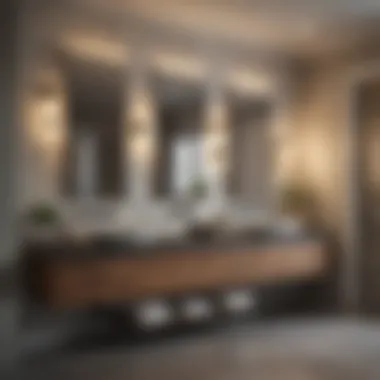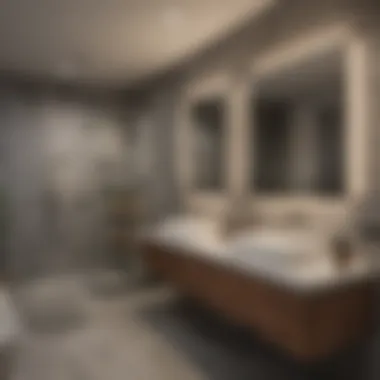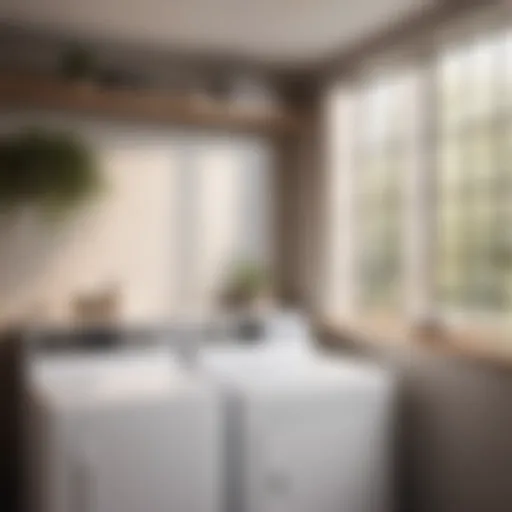72-Inch Double Sink Bathroom Vanity: Design & Benefits


Intro
Bathroom vanities have become more than just functional fixtures; they serve as the centerpiece of modern bathroom design. Among them, the 72-inch double sink vanities stand out, providing space and style to even the coziest of bathrooms. These vanities are practical for larger households, where a little less waiting time for a sink in the morning goes a long way. In this article, we’ll explore the nitty-gritty of selecting, installing, and enjoying these striking additions to your bathroom.
Whether you’re a seasoned DIY enthusiast or dipping your toes into this waters for the first time, there's a wealth of information waiting for you. We'll dig into the materials needed, step-by-step instructions, and provide technical specifications that you won't find in your typical home improvement guide. So roll up your sleeves; it’s time to transform your bathroom into a functional and aesthetically pleasing space.
Materials:
Getting your project underway starts with gathering the right materials. Below is the comprehensive list:
- Vanity Frame: 72 inches long, preferably made from solid wood or plywood for durability.
- Countertop: 1 slab measuring 72 inches by 22 inches. Granite or quartz are popular choices for their sturdiness and elegance.
- Sinks: 2 undermount sinks, with dimensions approximately 18 by 12 inches.
- Faucets: 2 matching faucets, preferably designed for widespread installation.
- Drain Assembly: 2 drain assemblies compatible with the sinks chosen.
- Cabinet Hardware: Pull handles and soft-close hinges to enhance functionality.
- Screws and Anchors: A box of wood screws for mounting the vanity and hardware.
- Sealant: Silicone sealant for water protection between the countertop and sinks.
Optional:
- Backsplash: Depending on your design choice, a backsplash can range between 4 to 6 inches, matching the countertop.
DIY Steps:
- Planning Your Layout: Measure your bathroom dimensions carefully to ensure the vanity will fit without crowding the space. Note the plumbing and electrical layouts.
- Preparation: Clear the area where the vanity will be installed. Remove any existing fixture and prepare the wall to receive the new installation, ensuring it's clean and dry.
- Assembling the Vanity: Start by constructing the vanity, attaching the legs and aligning the sides with screws. Ensure everything is level and squared for a good fit.
- Countertop Installation: Secure the countertop using adhesive and screws, ensuring it’s perfectly aligned with the base.
- Plumbing Setup: Install the sinks and faucets. Connect the water supply lines to the faucets and the drain lines to the sinks, making sure everything is watertight.
- Final Touches: Stand back and admire your work! Make any necessary adjustments, and ensure all fixtures are functioning properly.
Technical Aspects:
To elevate the project, here’s a list of tools and tips:
- Tools You'll Need:
- Timing and Techniques:
- A power drill
- Level
- Measuring tape
- Screwdriver
- Pipe wrench
- Caulking gun
- Expect to spend 4-8 hours on installation, depending on your skill level.
- Work on securing fixtures progressively and double-check alignments as you go.
DIY Project Process:
The following steps outline the installation method:
- Positioning the Vanity: Place the vanity in the desired location and use a level to ensure it is straight. Mark the positions for screws on the wall to secure the frame.
- Sink Installation: Following manufacturer instructions, lower the undermount sinks into their designated spaces, applying sealant as needed for a waterproof finish.
- Connect Faucets: Install the faucets before you connect the water supply. This process varies by model, so closely follow the guidelines given.
- Final Checks: Inspect for any leaks. Run water for a few minutes while watching for any issues that may arise in connections.
Troubleshooting Tips:
Even seasoned DIYers encounter mishaps. Here are some common issues and their fixes:
- Leaky Faucets: Ensure all fittings are tightly secured and check for worn washers.
- Diagnosis of Clogs, especially on drain lines can often be solved by clearing the line with a plumber's snake.
- Uneven Installation: Make adjustments with spacers as needed, or use a level to reposition the vanity and refasten.
"Investing time and effort into your bathroom upgrades pays off in long-lasting satisfaction and enhanced daily living space."
Now you're equipped with a thoughtful approach to installing a 72-inch double sink bathroom vanity that balances aesthetics with functional practicality.
Preface to Bathroom Vanities
Bathroom vanities are not just functional fixtures; they are central to creating a cohesive design in any bathroom. The relevance of this article lies in the exploration of 72-inch double sink vanities, which are increasingly popular among homeowners for their convenience and aesthetic appeal. A vanity serves multiple roles, transforming a simple bathroom into a luxurious space while accommodating essential daily routines.
Understanding the importance of the bathroom vanity in the overall design can lead to thoughtful choices that enhance both style and functionality. With a 72-inch double sink vanity, homeowners effectively address the need for space, particularly in shared bathrooms. This layout facilitates efficiency, allowing two individuals to utilize the sink area simultaneously.
Furthermore, a vanity's design significantly influences the overall atmosphere of the bathroom. A well-selected vanity can serve as a statement piece, showcasing unique materials and textures while complementing other elements in the space.
This section will explore key factors related to the definition and evolution of bathroom vanities, laying the groundwork for understanding the complexities involved in choosing the right fixture for any home.
Defining the Bathroom Vanity
A bathroom vanity typically consists of a cabinet and a countertop, often paired with one or more sinks. The vanity serves as the primary storage area for toiletries and other bathroom essentials. It effectively combines practicality and aesthetic appeal, making it a focal point of the room.
In essence, the vanity can be seen as a piece of furniture that offers both style and organization. The size, design, and finishes of a vanity can reflect personal taste, ranging from sleek, modern lines to ornate, traditional details.
For many families, the vanity is more than just a station for washing hands and brushing teeth; it can be a centerpiece for morning routines, fostering connection as family members prepare for their day.
Evolution of Bathroom Fixtures
The evolution of bathroom fixtures is quite fascinating. In the early days, bathrooms were often thought of simply as functional spaces with little emphasis on style. However, as the role of the bathroom has changed over time, so too have the fixtures within it.
From the basic washbasin to today’s luxurious double sink vanities, many advancements have occurred:
- In the 19th century, bathrooms began seeing more elaborate designs, often ornate and loaded with details.
- The mid-20th century introduced more streamlined designs focusing on minimalism and functionality.
- Recent trends highlight the importance of sustainability, using eco-friendly materials while still providing a high level of sophistication.
Today’s vanities feature innovative designs that provide storage solutions while enhancing the overall look of the bathroom. Homeowners can often find models made from reclaimed wood or featuring dual-fuel options for energy efficiency.
This evolution illustrates how essential bathroom vanities have become in both everyday life and the broader context of home design. Their development serves as a reflection of societal changes, particularly as bathrooms are increasingly seen as sanctuaries within the home.
Understanding the Double Sink Concept
When it comes to bathroom design, the double sink concept serves as more than just a trend; it’s a testament to practicality. Incorporating two sinks into your vanity setup offers a range of benefits that address needs for both functionality and aesthetics. This decision often hinges on lifestyle choices, family size, and bathroom layout. Understanding the nuances of a double sink setup is crucial for designing a space that enhances daily routines.
Advantages of Double Sink Vanities
Shared Space


The notion of shared space transcends mere physical dimensions. It represents a harmonious coexistence where multiple users can engage simultaneously without feeling crowded. This is especially beneficial in family homes, where mornings can quickly turn chaotic.
One key characteristic of shared space in double sink vanities is the elimination of bottlenecks during peak usage times. For instance, couples can brush their teeth, get ready for work, or engage in pre-bedtime rituals side by side. The unique feature here is the division of labor—less time waiting means more efficient morning routines.
However, there are potential downsides. If not planned correctly, shared vanity space may lead to clutter, as personal items can start spilling over. Finding strategies for organization, like designated drawers or shelves, is essential to make the most of this shared area.
Increased Convenience
The concept of increased convenience is at the heart of double sink vanities. With two separate sinks, households no longer contend with the issue of sharing a single faucet. Just imagine two people trying to use one sink at the same time—inevitably, one person ends up feeling rushed.
A hallmark of this convenience is the ability to personalize the sink experience, whether through differing faucet heights or styles. This allows homeowners to choose what best suits their family’s needs. Moreover, having two sinks means ample space for storage, making everyday living more manageable. On the downside, one might encounter the challenge of ensuring both sinks remain clean and functional. Regular maintenance becomes even more critical in this context, as neglecting one side can lead to uneven wear.
Enhanced Value
When assessing the enhanced value of adding a double sink to a bathroom vanity, the narrative extends beyond aesthetics. Real estate experts often point out that homes equipped with such features tend to attract buyers, as they exemplify luxury and functionality. The appeal lies in the fact that double sink vanities offer a sense of modernity, enhancing the overall design of a bathroom.
Unique to this feature is its adaptability to various bathroom styles, from sleek contemporary to classic traditional. However, with increased value comes increased responsibility—installing a 72-inch double sink vanity demands thoughtful attention to plumbing and space considerations.
Design Considerations
Size and Layout
The size and layout of a double sink vanity significantly influences its practicality and style. Opting for a 72-inch vanity strikes a balance between functionality and elegance. This width allows not just for two sinks but also ample countertop space, enabling users to keep everyday items organized and accessible.
One prominent characteristic is the variety in layouts—with options such as side-by-side configurations or vessel sinks that sit above the countertop. Choosing the right layout is necessary for maximizing both space and aesthetic appeal. A drawback, however, is that a larger footprint may not be suitable for smaller bathrooms. Homeowners need to carefully consider dimensions and orientations to ensure an ideal fit.
Footprint in Different Spaces
The footprint in different spaces dictates how well the double sink vanity integrates with existing bathroom environments. For a vast bathroom, a 72-inch vanity can serve as a stunning centerpiece. However, in tighter areas, the same size can dwarf the room, causing a sense of imbalance.
This brings us to an essential characteristic: adaptability. Homeowners can enhance their bathrooms with strategic adjustments, like floating vanities or slim sink designs that save space while still providing practicality. In contrast, a straightforward approach might be more convenient in larger layouts, leading to a cohesive design throughout.
A common concern is ensuring that there’s sufficient room to navigate around the sinks, particularly when cabinet doors open. Proper planning is crucial to avoid placement issues, ensuring access and flow remain unobstructed.
"The dimensions of a double sink bathroom vanity are not only about aesthetics; they embody a lifestyle where efficiency meets elegance."
Overall, understanding the double sink concept revolves around key elements. By considering shared space, convenience, and value alongside practical layout considerations, homeowners can make informed decisions that elevate their daily living spaces.
The Allure of 72-Inch Width
When it comes to bathroom vanities, the dimensions hold significant importance, with the 72-inch width standing out as not just a choice, but almost a statement. This size exudes a sense of luxury while maintaining a high level of functionality. A 72-inch double sink vanity allows couples to share space harmoniously, eliminating the morning rush that many households face. But there is more to this generous width than meets the eye.
Balancing Functionality and Style
A 72-inch width effectively marries functionality with aesthetics, making it easier to achieve a well-designed bathroom that also serves practical needs. This ample space allows for larger sinks and countertops, providing room for personal items like soaps, towels, or even decorative elements like plants or candles. Beyond mere utility, a double sink vanity of this dimension can become the focal point of your bathroom, drawing attention to its design, be it sleek modern or ornate traditional.
"The right width can transform an everyday routine into a luxurious experience."
In essence, the 72-inch vanity is a canvas. Its size invites creativity, enabling homeowners to incorporate various styles and materials that reflect their personal taste. From elegant marble to rustic wood finishes, the design choices are virtually limitless.
Integrating within Different Bathroom Sizes
While the allure of a 72-inch vanity is undeniable, its successful integration into different bathroom dimensions is a critical consideration.
Ideal Bathroom Dimensions
When considering bathroom dimensions for a 72-inch double sink vanity, the overall space typically should measure at least 10 x 12 feet. This configuration not only accommodates the vanity but also allows clearance for movement around it, ensuring that the bathroom doesn't feel cramped. A minimal layout with the vanity backed against a wall can help in creating a practical design setup, leaving room for other crucial fixtures such as the toilet and shower.
The key characteristic here lies in almost creating a small suite-like feel to the restroom, where everything is in its place without feeling congested. Ideal bathroom dimensions encourage an open layout, which enhances the usability of the area, making it a beneficial choice for creating a serene environment.
Considerations for Smaller Spaces
Taking a 72-inch double sink vanity into consideration for smaller spaces can be challenging yet rewarding. In powder rooms or compact bathrooms, the vanity can still fit, but strategic planning extends beyond mere measurements.
One unique aspect is that this size can often take up more room than one might first think. To balance size, consider alternatives like wall-mounted faucets or smaller basins that free up counter space. Maintaining this counter room gives a sense of openness.
Smaller bathrooms can benefit from designing the area with mirrors and lighter color palettes. These elements can give an illusion of space, making the bathroom feel larger than it is.
When choosing to insert a 72-inch vanity in tighter quarters, the advantages include optimizing functionality without sacrificing style; however, it does require foresight in planning to avoid blockages in movement.
Material Choices for Durability and Aesthetics
The selection of materials used in a 72-inch double sink bathroom vanity is not just a matter of aesthetics. It's also about durability, maintenance, and overall functionality. The right material can enhance the vanity's appearance while ensuring it can withstand daily use and moisture exposure. When homeowners consider a double sink vanity, they should prioritize materials that balance these factors effectively.
Common Materials Used
Wood
Wood is often heralded for its warmth and versatility in design. A key characteristic of wood is its ability to blend seamlessly with various styles, from rustic to modern. When treated properly, wood can be an incredibly durable choice. This material often features unique grains, adding a bit of artistry to each piece.
However, one must be cautious with wood in bathroom environments. Its susceptibility to moisture is a notable downside. Without proper finishing or sealing, wood can warp or develop mold over time, particularly in humid conditions. Thus, when selecting wood, opt for higher quality, moisture-resistant varieties such as teak or oak.
Stone
When it comes to durability, stone stands out for its strength and resilience. Granite, marble, and quartz are frequently used options. A significant advantage of stone is its natural beauty, making each slab unique and able to complement a variety of decor styles.


Stone's natural properties mean it's highly resistant to heat and scratches, making it a practical choice for high-traffic bathrooms. However, caution is required as stone can be porous, which means it can absorb liquids if not sealed properly. Regular maintenance, such as resealing, is key to prolonging the life of a stone vanity.
Composite Materials
Composite materials present an innovative solution for bathroom vanities. These man-made materials are typically designed to look like natural stone or wood, but they often offer enhanced durability. The most significant aspect of composites is their resistance to scratching and staining, making them an excellent choice for busy households.
Furthermore, composite materials are often lighter than solid wood or stone, making them easier to handle during installation. However, not all composites are created equal; some may not handle heat as well as natural materials, so it’s essential to review product specifications carefully.
Finishes and Their Impact
The finish applied to your vanity can dramatically alter both its look and functionality.
Glossy vs. Matte
The debate between glossy and matte finishes can be a point of contention among homeowners. A glossy finish tends to reflect more light, making spaces feel larger and brighter. It is also easier to clean, as spills can often be wiped away with minimal effort.
On the flip side, matte finishes can provide a more understated elegance and hide fingerprints or water spots more effectively. However, they may require more diligent cleaning since they can absorb some stains or accumulate grime over time. Choosing between the two often comes down to personal preference and lifestyle needs.
Color Choices and Trends
Color is not merely aesthetics; it’s a means of expression. The color choices for a 72-inch double sink vanity can significantly influence the overall bathroom ambiance. Neutral tones such as whites, grays, and beiges remain popular, providing a classic and timeless feel.
Conversely, bold colors can make a statement and inject personality into a space, but they may not appeal to everyone. Trends shift over time, but investing in colors that resonate with your style ensures your washroom remains enjoyable.
Ultimately, material choice and finish choices hinge on balancing beauty with utility. Each material presents both unique advantages and considerations. Careful planning ensures your bathroom vanity not only looks good but serves its purpose for years to come.
Functional Features to Consider
When diving into the world of 72-inch double sink bathroom vanities, functional attributes deserve just as much attention as aesthetics. These features often determine how well a vanity adapts to your lifestyle and meets your family's needs. Comfort and convenience in everyday use can be significantly enhanced by thoughtfully selected functional characteristics. As such, whether you're washing hands or getting ready for the day, these elements will ultimately make or break your experience with your vanity.
Storage Solutions
Cabinet Styles
Cabinet styles contribute not merely to organization but to the overall appeal of your vanity. The primary characteristic of cabinet styles in the context of bathroom vanities is their ability to blend seamlessly with different design sensibilities while offering adequate storage space.
One popular choice is the Shaker style, noted for its simple lines and functionality. Its minimalist design suits modern tastes while providing ample room to store bathroom essentials out of sight. The distinct advantage of this style is its versatility; it easily complements both contemporary and traditional decors. Conversely, a raised-panel cabinet, often found in more ornate configurations, adds a touch of elegance, allowing homeowners to express their personal style.
Some cabinet styles, however, can be less practical in smaller bathrooms. For instance, a full-overlay cabinet may offer a sleek appearance but can be more challenging to repair if damaged.
Drawer Configurations
Drawer configurations are another pivotal aspect of your bathroom vanity's functionality. The main characteristic to consider is how these drawers can be organized to enhance utility. A common and favored option is the inclusion of deep drawers, which are highly regarded for their capacity to accommodate bulky items like towels or hair dryers, providing easy access without the fuss.
Furthermore, pull-out drawers can be outfitted with dividers for added organization—a beneficial choice that allows you to keep smaller items neatly sorted, making it straightforward to retrieve what you need without digging around. However, one drawback is that intricate configurations may become cumbersome if not correctly maintained, leading to potential frustration with usability over time.
Plumbing Considerations
Getting down to plumbing means addressing the nuts and bolts, quite literally, of your double sink vanity. Understanding these requirements is essential for ensuring a smooth installation process and operational efficiency.
Installation Requirements
Installation requirements focus on the precise demands of fitting a vanity sky-high in style yet low on fuss. This involves ensuring that your plumbing can accommodate double sinks—a specific requirement that can complicate installations in homes where existing plumbing is centralized for only one sink.
It’s also important to consider the dimensions of your plumbing fixtures, like traps and supply lines. When selecting a vanity, a pivotal consideration is ensuring that it allows adequate access for necessary maintenance and repairs. The upside of planning for these specifics thoroughly is that they reduce headaches down the line, but it can feel quite overwhelming for the uninitiated at the start.
Drainage and Sink Types
Finally, drainage and sink types round off the plumbing discussion. Knowing which types work best with a 72-inch vanity can save you time and cash in the long run. The pop-up drain, for instance, boasts significant functionality, enabling easy access with just a push. This type is also often simpler to clean, enhancing its appeal.
In terms of sinks, undermount designs are popular due to their seamless integration with countertops, providing a sleek and uncluttered look. However, these require precise measurements to avoid potential installation woes.
Opting for inadequate drainage or sink type can spell trouble down the road, leading to drainage issues that could necessitate costly repairs.
Key Takeaway: Prioritizing functional features, particularly regarding storage solutions and plumbing concerns, is essential. These aspects greatly influence both the utility and lifespan of your 72-inch double sink bathroom vanity.
Aesthetic Variations in Design
When it comes to designing a bathroom, aesthetics don't just serve the eye; they're critical in creating a space that resonates with personal style and functional needs. The beauty of a 72-inch double sink bathroom vanity lies in its potential to be both a statement piece and a practical fixture. The range of styles available influences how a bathroom feels, shapes the overall theme, and enhances the user experience.
Modern vs. Traditional Styles
Choosing between modern and traditional styles is like picking the perfect spice for your favorite dish. Each evokes a unique ambiance and speaks to different tastes.
Modern styles, characterized by sleek lines and minimalistic designs, often prioritize functionality. Think of a vanity with a glossy finish, sharp angles, and large mirrors that create an illusion of space. This look pairs well with contemporary fixtures, such as wall-mounted faucets, and can include playful elements like bold color choices, ensuring the vanity stands out without overwhelming the room.
On the other hand, traditional styles embrace ornate details and natural materials. Picture a classic wooden vanity with intricate carvings or a warm, rich stain that commands respect. Traditional vanities often incorporate vintage sinks and antique bronze hardware, lending an air of sophistication. A timeless design can create a cozy, inviting atmosphere that appeals universally across generations.
Customization Options
No two homeowners are exactly alike, which is where customization shines in vanity design. Tailoring your vanity to fit specific needs and preferences can transform how the space works for you.
Vanity Tops


The vanity top plays a crucial role in both aesthetics and function. It’s not just about looks; it directly impacts durability and maintenance. Common materials for vanity tops include quartz, marble, and granite. Each option brings its own set of strengths. For instance, quartz is non-porous and easy to clean, making it a favored choice for busy households where time is of the essence.
On the flip side, marble, though breathtakingly beautiful, requires more care. Its porous nature means spills must be wiped immediately, which can be a hassle. However, its unique veining gives each top distinct character. This variety offers buyers a chance to pick a material that fits their lifestyle while enhancing the overall look of the bathroom.
Sink Styles
Similarly, the type of sink also significantly influences the vanity's functionality and style. Under-mount sinks create a seamless look, allowing for easy cleaning of the vanity top, while pedestal sinks often call for additional support.
Console sinks, with their elegant legs, can be a dramatic focal point but come with less storage. Drop-in sinks are versatile and common. They offer a classic look that integrates smoothly with any vanity style. When selecting a sink, consider how its design interacts with the overall aesthetic, along with practical concerns like ease of use and cleaning.
Ultimately, the blend of different aesthetic options plays a pivotal role in marrying your home's style with your day-to-day needs. You’re not just investing in fixtures; you’re shaping an experience.
By understanding these aesthetic variations and carefully considering how each element contributes to the overall design, homeowners can create a serene sanctuary or a bold statement, reflecting their unique tastes and lifestyle.
Installation Insights
Installing a 72-inch double sink bathroom vanity isn't just about placing it on the floor; it's a labor of love that encompasses planning, precision, and an eye for detail. In this section, we’ll explore the various elements that contribute to a successful installation. Ensuring a correct installation not only impacts functionality but also influences the overall aesthetic of your bathroom, making this segment a crucial part of the vanity's journey from concept to completion.
Choosing the Right Location
When it comes to installing your double sink vanity, location is king. Selecting the right spot plays a significant role in both usability and visual balance within your bathroom. Several factors ought to be taken into account:
- Plumbing Access: This is perhaps the most vital consideration. Ensure your chosen location allows easy access to existing plumbing. If you have to relocate pipes, you can face significant costs.
- Space and Flow: The vanity must not impede the natural flow of the room. Think about how it fits with other fixtures like the toilet and shower. Ideally, there should be enough space on either side for ease of access.
- Lighting Conditions: Natural light can enhance the look of your vanity. If possible, position it near a window or in a well-lit area, which helps in both utility and aesthetics.
- Privacy: In larger bathrooms, it’s often overlooked, but you should consider how the vanity placement affects the level of privacy from the door and other areas.
"The right location for your vanity can turn a functional space into a centerpiece."
By weighing these factors carefully, you can avoid many common pitfalls and set the stage for a successful installation.
Hiring Professionals vs. DIY
When it comes down to the actual installation of your vanity, you'll face an important decision: hire a professional or go the DIY route. Both options have their distinct pros and cons, and weighing them can save you time, money, and stress in the long haul.
Cost Considerations
Cost is a key characteristic that significantly influences your decision.
- Hiring Professionals: While this can be pricier up front, it generally assures you of a job well done. Professionals are equipped to handle complicated plumbing or structural adjustments. Reliable contractors usually offer warranties and longer-term peace of mind.
- DIY Approach: This method can feel like a no-brainer for those on a budget. However, calculating the actual cost factors isn’t always straightforward. Besides the direct costs of materials, do not forget to add any tools you might have to buy or rent. Moreover, the time spent and potential mistakes can lead to further costs down the road.
In essence, if you're keen on cutting edges while navigating the world of costs effectively, remember to balance initial savings with future needs.
Skill Requirements
Skill requirements should also inform your choice between professional help and a DIY project.
- DIY Skills: Undertaking a bathroom vanity installation on your own seems appealing, especially if you're handy or have some previous experience. However, it requires meticulous attention to detail and a clear understanding of plumbing and carpentry.
- Professional Skills: Hiring an expert brings a wealth of experience to the table, which can speed up the process and typically results in a higher standard of finish. They have honed their skills over time, which can prove invaluable, especially when unforeseen issues arise.
Ultimately, if you're committed to getting your hands dirty and have the necessary skills in your toolkit, a DIY installation could be rewarding both financially and personally. However, if even a single doubt lingers, engaging a professional is often the safer route.
By understanding these critical aspects of installation, you can confidently navigate the process and prepare to enjoy your beautifully installed 72-inch double sink bathroom vanity.
Maintenance and Care
Maintaining a 72-inch double sink bathroom vanity holds significant weight in ensuring not just its longevity but also its aesthetic appeal. With the hustle and bustle of daily life, it can be easy to overlook the upkeep of such a central fixture. However, regular maintenance can prevent minor issues from spiraling into costly repairs. Moreover, a tidy and well-kept vanity promotes a pleasant bathroom atmosphere, something that reflects your style and enhances your home.
Daily Upkeep
Daily upkeep is like the morning cup of coffee for your vanity – it keeps everything running smoothly. A simple routine can go a long way in preserving the beauty of your setup. Here are some engrossing tips for a seamless daily maintenance routine:
- Wipe Down Surfaces: A quick swipe with a soft cloth can remove moisture and soap residue that often accumulates around the sinks. Using a microfiber cloth is a smart choice; it reduces lint and won’t scratch the finish.
- Check for Leaks: A daily glance beneath the sinks to check for any signs of leakage can save headaches down the road. A drop here and there can lead to bigger issues if not addressed quickly.
- Organize the Counter: Keep the countertop clutter-free. Return stray items to their designated spots, ensuring that the vanity remains functional and stylish.
While these tasks are small and simple, they yield significant benefits. It’s like having a well-oiled machine – everything runs better when you take care of the details.
Deep Cleaning Techniques
Deep cleaning is akin to a spa day for your vanity. It not only refreshes its appearance but also protects its surfaces from wear and tear. Considering the size of a 72-inch double sink vanity, a thorough cleaning can be quite the endeavor, but it's well worth it. Here’s how you can tackle this task effectively:
- Clear the Vanity: Start by removing all items from the surfaces and cabinets. This allows for a thorough cleaning without obstructions.
- Use the Right Cleaners: Depending on the material of your vanity, you’ll want to utilize appropriate cleaners.
- Scrub and Rinse: Using a soft sponge, work your way from the top down, scrubbing surfaces thoroughly before rinsing them with clean water. Don’t forget to pay attention to the sink bowls where grime can accumulate.
- Dry Completely: Always ensure surfaces are completely dried after cleaning, to prevent the buildup of mold or mildew, which thrives in damp conditions.
- Condition the Wood: If your vanity has wooden components, applying a wood conditioner can restore its luster after deep cleaning.
- For wood: A mild soap and water solution is often best, followed by a soft dry cloth to prevent damage.
- For stone surfaces: A gentle pH-neutral cleaner helps maintain the finish without etching.
- For composite materials: Check the manufacturer’s guidelines; they may provide specific recommendations.
Taking the time to deep clean your vanity may feel like a chore, but the elegance and longevity you gain are invaluable.
Remember, a well-maintained vanity is not just a reflection of good housekeeping; it's an investment in your home that pays dividends in both enjoyment and value.
Ending
The importance of a conclusion in this article cannot be overstated. It's the capstone that brings together various threads discussed throughout the piece, and its relevance shines brightly in a few specific areas. First, it underscores the multitude of benefits that a 72-inch double sink bathroom vanity offers, from enhanced functionality to aesthetic appeal. Homeowners need to grasp not only why they should consider such vanities but also how they elevate the bathing experience in both practical and stylish ways.
Reflecting on the Benefits
A double sink bathroom vanity is not just another fixture—it's a transformative piece that enhances the entire bathroom atmosphere. With two sinks accommodating simultaneous use, couples can save time during busy mornings or evenings. Imagine the ease of getting ready without the frustrating wait for the faucet. This feature alone makes a compelling case for many families. Additionally, the ample storage options that often come with a 72-inch vanity can help keep toiletries and accessories organized, promoting a tidy and serene environment.
Moreover, from a resale perspective, the added value of a well-chosen vanity shouldn't be overlooked. Potential buyers often equate a spacious and functional bathroom with a well-run household. Thus, investing in this kind of vanity may offer dividends when the time comes to sell.
Looking Ahead to Future Trends
As we look down the pipeline, several trends are emerging in the realm of bathroom design that promise to shape how we view double sink vanities in the years to come. Sustainability is becoming a focal point for many homeowners. Expect the materials used in these vanities to evolve, incorporating eco-friendly options without sacrificing beauty or durability. Picture reclaimed wood and recycled glass as staples in the bathrooms of the near future.
Design aesthetics are also shifting toward more minimalist approaches. Clean lines, neutral colors, and multi-functional furniture pieces are gaining traction as homeowners prioritize open and airy spaces. This trend could see double sink vanities featuring sleek, unobtrusive designs while maximizing utility. Keeping a finger on the pulse of these shifts can guide potential buyers in making informed decisions, ensuring their selections remain stylish and relevant for years ahead.
As you reflect on what this article reveals, consider the many layers to choosing a 72-inch double sink vanity. It's not merely a matter of size or functionality—it's about crafting a bathroom oasis that marries beauty with practicality. So, as you plan for updates or new installations, remember the benefits and the trends signaling the way forward.







